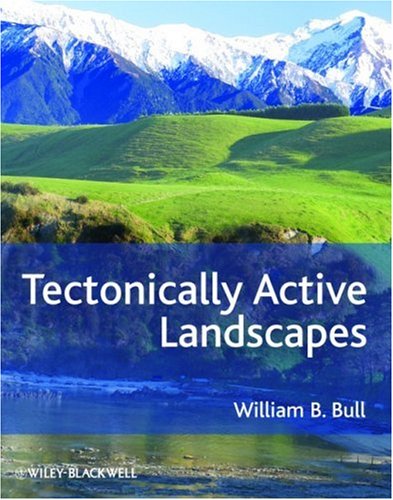

Most ebook files are in PDF format, so you can easily read them using various software such as Foxit Reader or directly on the Google Chrome browser.
Some ebook files are released by publishers in other formats such as .awz, .mobi, .epub, .fb2, etc. You may need to install specific software to read these formats on mobile/PC, such as Calibre.
Please read the tutorial at this link: https://ebookbell.com/faq
We offer FREE conversion to the popular formats you request; however, this may take some time. Therefore, right after payment, please email us, and we will try to provide the service as quickly as possible.
For some exceptional file formats or broken links (if any), please refrain from opening any disputes. Instead, email us first, and we will try to assist within a maximum of 6 hours.
EbookBell Team

4.3
78 reviews
ISBN 10: 1405190124
ISBN 13: 9781405190121
Author: William B Bull
This book explores how mountainous landscapes respond to tectonic deformation. It integrates previously unpublished concepts and ideas with recent articles about hills and streams. Readers will learn which landforms change quickly in response to uplift, which parts of the landscape are slowest to adjust to tectonic perturbations, and which landform characteristics are most useful for describing tectonically active and inactive terrains.
Study areas include diverse landscapes and tectonic settings: seacoasts, soil-mantled hills, and lofty mountains. The humid Southern Alps of New Zealand change quickly because of rapid uplift and erosion. The semiarid Panamint Range of southeastern California has such miniscule annual stream power that tectonic landforms persist for millions of years.
Tectonically Active Landscapes addresses diverse key topics about tectonics and topography. It is essential reading for research geologists and advance-level undergraduate and graduate students in the earth sciences.
PART 1 — TECTONIC SETTINGS AND SCOPE OF INQUIRY
1 Study Regions
1.1 Introduction
1.2 North America-Pacific Plate Boundary
1.2.1 Walker Lane-Eastern California Shear Zone
1.2.1.1 Panamint Range
1.2.2 Sierra Nevada
1.2.3 Diablo Range
1.2.4 Mendocino Triple Junction
1.3 Australia-Pacific Plate Boundary
1.4 India-Asia Plates Collision
1.5 Aegean Transtension
PART 2 — RESPONSES OF HILLSLOPES TO BEDROCK UPLIFT
2 Drainage Basins
2.1 Hydraulic Coordinates
2.2 Basin Shapes
2.2.1 Panamint Range Watersheds
2.3 Divide Migration and Stream Capture
2.3.1 Stream Capture and Changing Geomorphic Processes
2.3.2 Drainage-Basin Evolution in a Fold and Thrust Belt
2.3.2.1 Wrench-Fault Tectonics
2.3.2.2 Mt. Diablo Fold and Thrust Belt
2.4 Tectonically Translocated Watersheds
3 Hillslopes
3.1 Hillslope Model Boundaries
3.2 Late Quaternary Tectonic Deformation of the Diablo Range Study Area
3.3 Sediment Flux and Denudation Rates
3.4 Ridgecrests
3.4.1 California Coast Ranges
3.4.2 Badlands
3.5 Canyonlands
3.5.1 The Loop of the San Juan River
3.5.1.1 Footslopes
3.6 Cross-Valley Shapes
3.6.1 Lithologic Controls
3.6.2 Tectonic Controls
3.7 Tectonic Signatures in Hillslopes
4 Tectonic Controls on Hillslope Denudation
4.1 Sediment Yield
4.1.1 Influences of Rock Uplift
4.1.2 Lithologic Controls
4.2 Mass Movements
4.2.1 Rain, Ground-Water Levels, and Landslide Thresholds
4.2.1.1 Ground-Water-Induced Stresses in Hillslopes
4.2.1.2 Rain and Hillslope Stability
4.2.2 Landslides of Tectonically Active Regions
PART 3 — TECTONICS AND TOPOGRAPHY
5 A Debate About Steady State
5.1 A Century of Conceptual Models
5.2 Hillslope Degradation
5.3 Erosion of Mountain Ranges
5.3.1 Southern Alps
5.4.2 Sierra Nevada and Appalachian Mountains
5.4 Non-Steady State Erosion of Tectonically Active and Inactive Fluvial Systems
6 Influences of Erosion on Tectonic Deformation and Fault Propagation
6.1 Exfoliation
6.2 Ridgecrest Spreading
6.3 Erosional Controls of Fault Zone Partitioning
6.4 Consequences of Erosion Induced by Long-Term Plate Collision
6.5 Fault Propagation
6.5.1 Normal Faulting
6.5.1.1 Nevada Basin and Range Province
6.5.1.2 Greece
6.5.2 Thrust Faulting
6.5.2.2 New Zealand
6.5.2.2 California
7 Tectonic Geomorphology of a Plate Boundary
7.1 Walker Lane-Eastern California Shear Zone
7.1.1 Panamint Range
7.2 Sierra Nevada Microplate
7.2.1 Present Topography
7.2.2 Geomorphic Responses to an Uplift Event
7.3 Mendocino Triple Junction
7.3.1 Marine Terraces
7.3.2 Stream Channels
7.3.2.1 Independent Variables for Coastal Fluvial Systems
7.3.2.2 Fluvial System Responses to a Shifting Plate Boundary
tectonically active landscapes book
tectonically active landscapes bull
what are the tectonically active areas on earth
tectonically active meaning
most tectonically active region
what can earthquakes do to change the landscape
Tags: William B Bull, Tectonically, Landscapes